Our Summer Cruise 2019
June 9 - 15 |
June 16 - 22 |
June 23 - 29 |
June 30 - July 6 |
July 7 - 13 |
July 14 - 20 |
July 21 - 27 |
Jul 28 - Aug 3 |
Aug 4 - 10 |
Aug 11 - 17 |
Aug 18 - 24 |
Aug 25 - 31 |
Sep 1 - 7 |
Sep 8 - 14 |
Sep 15 - 21 |
Sunday, June 23
The weather is looking good for a hike today after much rain last night but we decided to let it warm up a little while I took care of one of the small boat jobs first .... installation of a Maretron DSM250, basically a multi readout gauge that can display just about any data from barometric pressure to boat position. It turned out to be a relatively simple job; cut a rectangular hole in a panel, bolt the gauge in, and hook up a couple of cables and presto - it worked! ... all in one hour. Although it looks simple, the manual is 190 pages long - some light bedtime reading, before trying to program in the various screens.

The Last Instrument I Will Ever Need
Northeast Harbor and some of the surrounding communities are where a number of the rich and famous spend their summers and one of them came rumbling into the Harbor on a blacked-out powerboat that pulled into a nearby slip. It turns out it is a Wally, custom-built in Monaco for Dick Wolf, the creator and producer of the Law and Order and Chicago TV series. He can make short work of traveling around since it will cruise at over 50 kts.
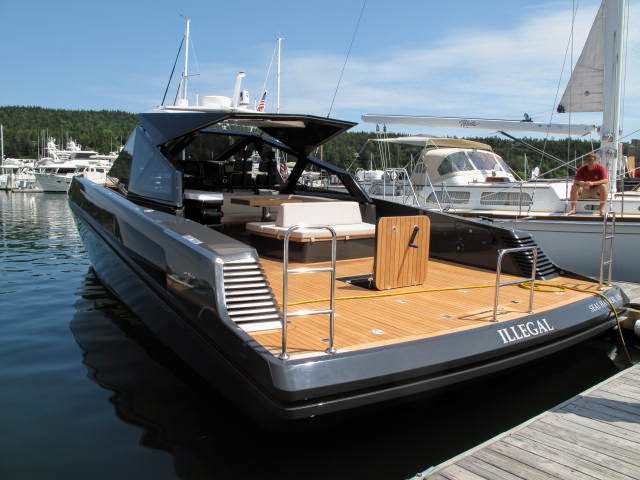
58 Foot Wally
We timed our arrival in NE Harbor perfectly since the Island Explorer buses start their season today. The Island Explorer is a fare-free seasonal, propane-powered bus system that runs throughout the Acadia National Park and the surrounding communities. Funding comes from L.L. Bean, Friends of Acadia, local communities and businesses and rider donations. Ten routes are operated, most on a half-hourly schedule and carry over half a million riders each season.
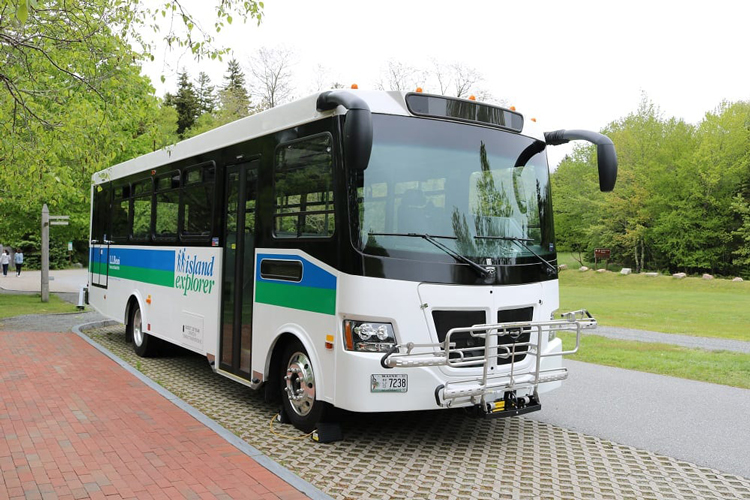
One of the Many Island Explorer Buses
We jumped on the first bus of the day at 10:15 to go to Jordan Pond where we planned to do a short hike of about 4 miles) around Jordan Pond.
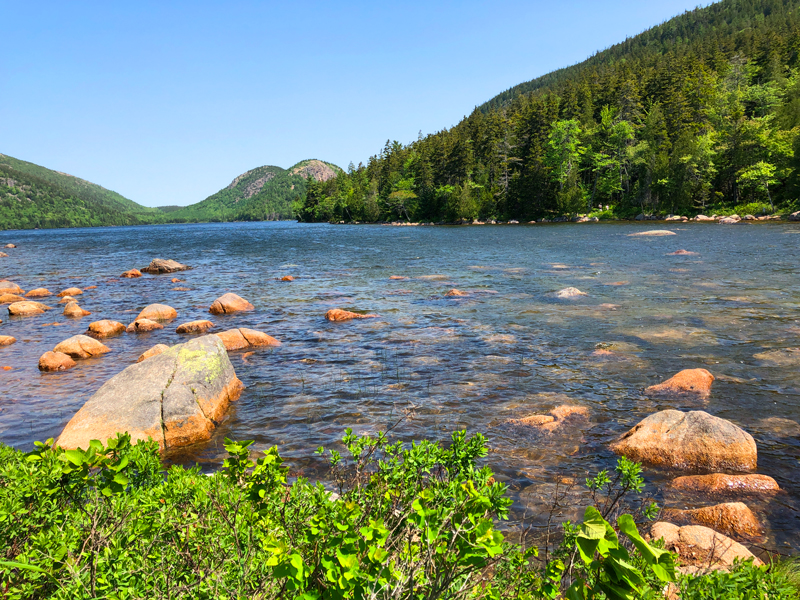
Looking North on Jordan Pond with the Bubbles in the Distance
The Pond is a glacial tarn or lake formed by the Wisconsin Ice Sheet during the last glacial period and had a depth of 150 feet with crystal clear water. It is a major source of drinking water on MDI. The well- traveled trail runs along the shoreline just a few feet from the edge of the pond passing over flat graveled paths, large rock and finally a mile long boardwalk along the western boggy shore. Unfortunately, about 1/3 of the board walk was under repair so we had to take to a very muddy alternate trail ... fine for us with good boots but a lot of pink Nikes were no longer pristine!

After a relatively short stroll in the park (literally), we ended up back at the Jordan Pond House which is the major restaurant in the Acadia National Park. Popovers with butter and jam and a pot of tea were our reward.

..... and You Get Two of These
Well fed, we hopped on the bus back to NE Harbor getting a good view over the moorings from up high.
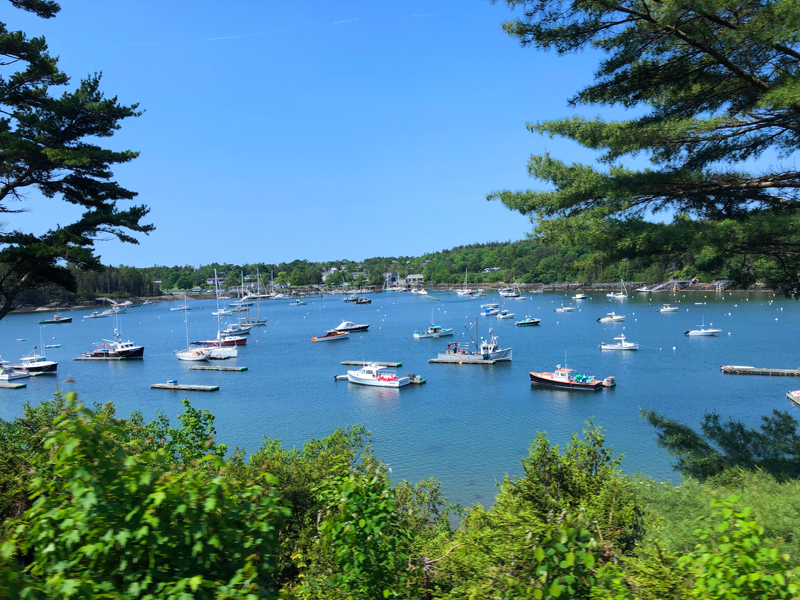
View of Northeast Harbor from Asticou Inn
Our timing was good as not long after we got back on the boat, a series of short but strong downpours arrived that continued well into the evening .. at least past our bedtime.

Monday, June 24

Northeast Harbor to Bar Harbor - 14nm
The storms from the previous night had well cleared Northeast Harbor by early morning and we awoke to a crisp but sunny morning. With no deadlines, we had a leisurely start to the day before leaving around 11:00 am for the short voyage around the east side of MDI to Bar Harbor.
The images we include in the blog are screenshots taken on our iPhones or iPad of a nautical chart app, Navionics. We have similar electronic charts on our computer and on a large screen chart plotter the screen of which is shown below. At this time, the left half shows the chart with us in red while the right upper part shows what our radar is seeing. The white circles with lines are moving targets (boats in this case). The lower right gives information from our autopilot that steers the boat automatically from predetermined point to a destination point. We typically use the autopilot in open water where traffic is light and it will hold a course probably better than we could do. At this point, the boat is 6 yards off course; often we will see less than that!

Chart plotter Screenshot
So the nautical chart is equivalent to a road map except that it does not have streets with names or directions for getting from A to B. A chart shows the landmasses and the surrounding waters using a certain scale. Regardless of whether the chart is paper or electronic, the water part of the charts has contour lines much like a topographical map and typically has color shading to denote areas of the same depth range. There are also specific depth numbers throughout the water areas. Hazards are marked in a number of ways. The explanation of all of the possible chart features take up a whole book about 3/8" thick. The most common features or "aids to navigation" are numbered buoys or colored floats. Those below have lights and bells activated by wave action.
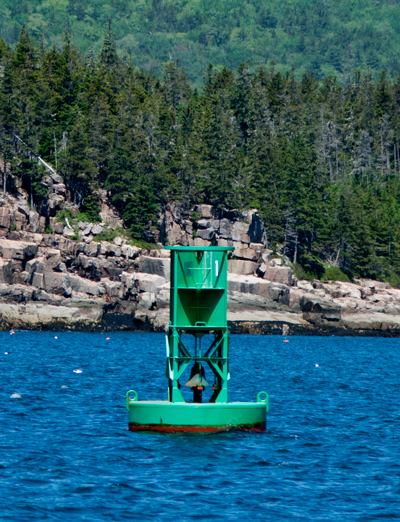

Green Buoy No.1.......................................Red Buoy No.2
As a general rule, one keeps the green on the left (or port) side of the boat and the red on the right (or starboard) side of the boat when returning from the sea; "Red Right Returning" is the mantra drilled into every sailor. Following this rule should keep one out of trouble providing one avoids other noted hazards!
The sounds simple and it is when entering an estuary from the open sea but can be problematic when one is inland in a complex group of islands and there is no clear "return." Then the convention goes out of the window and one relies on the chart. Many a sailor has become confused and run aground by not paying attention to a change in the buoyage scheme. A wise navigator verifies each buoy against the chart as it is passed. All told, there are over another 50 types of buoy a chart may include to denote specific features a boater needs to be aware of.
Certain prominent points of land or hazards may also be indicated by a light of some type ranging from a lighted pylon to a 250 ft.. lighthouse. Each has unique light characteristics such as color and flash frequency so that it can be readily identified by comparison with the chart.
To get from A to B on the water is different than driving a route by car. We have no set roads to follow; our goal is to stay in the wet stuff and not hit the land below or at the edge of the water. Another consideration is minimizing the distance between A and B. Factoring in adverse currents, tides, and weather also complicates planning a route.
Things have come a long way in route planning from the time where one sat down with a paper chart and laid out a route with pencil and rule usually as a series of straight lines and then figured the location of each course change. Today, we can put a starting point dot on an electronic version of a chart on our iPhone and another dot at our destination and the app will calculate the "best" route. Entering boat data such as boat draft and average speed enables the app to choose water of the correct depth and give us each course change point, ETAs, etc. Our chart plotter lacks this automation but the iPhone gives us a good starting point in route planning. New chart plotters can essentially help the vessel function like a driverless car plotting a route and going from A to B with a push of one button. However, the human element is still essential.
Blind reliance on the app route is not wise and we always go mile by mile over the suggested route on the chart plotter looking for hazards that may have been overlooked or marginal passages.
When we have a safe route entered into the chart plotter, the autopilot gives us the ability for the boat to self-steer from our starting point via each route point to the destination with no intervention on our part. That rarely happens as we usually encounter other boats we have to avoid, lobster trap floats in our path, adverse wave direction, etc. However, we often use the autopilot to steer from point-to-point on our route since it does a great job and makes a long trip more enjoyable. In bad weather, the autopilot is definitely superior to hand-steering.
Our route to Bar harbor was relatively simple with a number of short straight legs approximating a curve along the rugged coastline of MDI with a number of summer cottages/homes of the rich and famous.
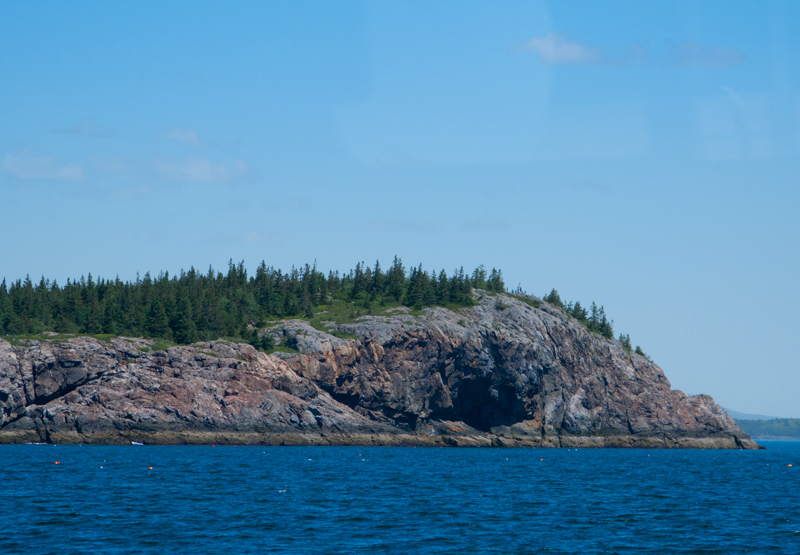

With a couple of hours, Bar Harbor was in sight and so were two large cruise ships, Royal Caribbean's "Adventure of the Seas" and Celebrity's newly refurbished "Summit." Bar Harbor has become a major Northeast cruise port over the past five years and several ships a week stop here during the season which extends into the Fall for tree colors.
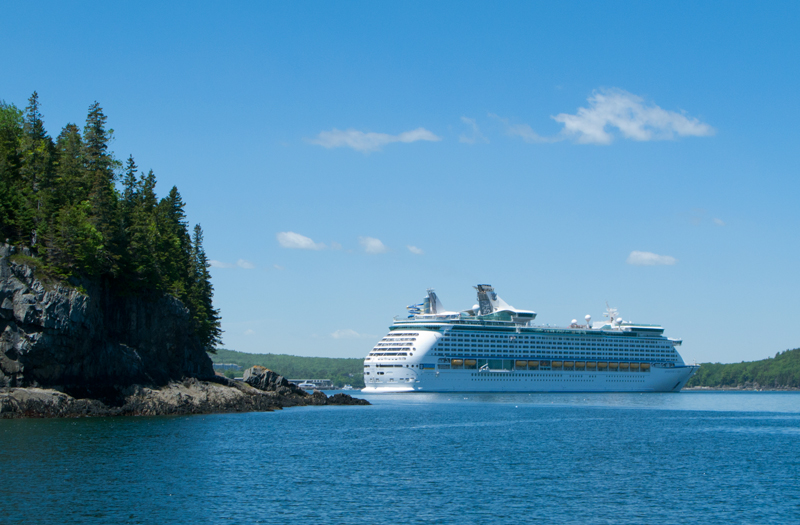
Adventure of the Seas

Summit
We thought this one was cuter at our anchorage at the College of the Atlantic.
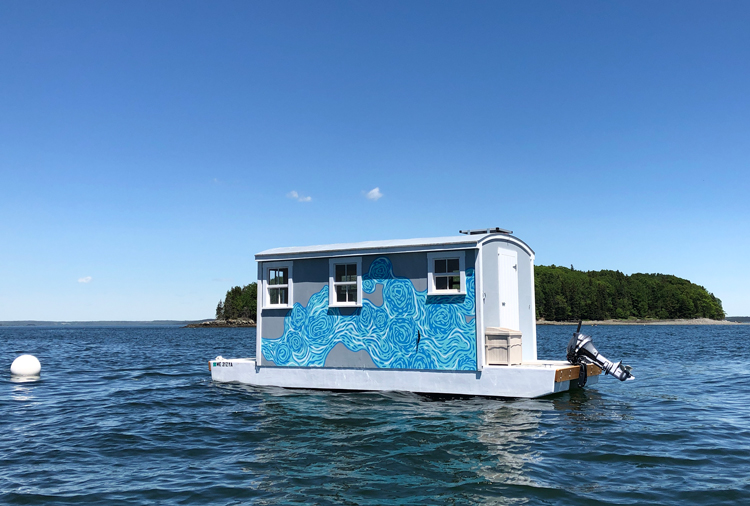
Captain Toby had taken care of us and we had a sturdy mooring ball for the rest of the week just offshore of the COA dock. The College maintains about sixteen mooring balls in the Bay of the school's property, most for seasonal use but they have always had a few available for transients like us. If all are in use, there is plenty of anchoring room with good holding in at least 12' at low tide.
The College was hosting the:
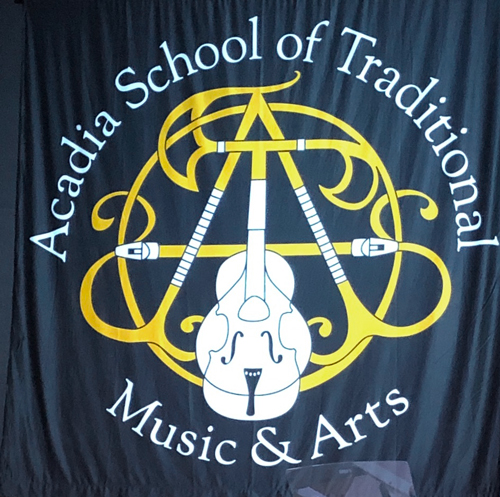
for the seventh year. This week-long event is the School's main event of the year with a jam-packed week of classes, workshops, jam sessions, concerts and dances. Focusing on the Irish, Scottish, Québecois, Acadian, Cajun, Old-Time and Cape Breton styles, They have almost 30 world-class teaching staff offering programs for fiddle, guitar, mandolin, bouzouki, cello, piano, piano accordion, banjo, pipes, whistle, bodhran, dance, song and more.
Our primary interest is the nightly concerts held through the week culminating in the student concert and contradance on Friday.
We spent some time in Bar Harbor wandering around; it was very busy with the extra 4000 people off the two cruise boats. Once again we visited the supermarket to stock up with a few extra things.
At 6:00 pm, we headed ashore to collect our tickets for the first concert and by 7:00 the music was underway!
Eight of the Thirty Faculty Getting Down
A great two and a half hour concert before piercing our way through the fog back to STB.
Tuesday, June 25
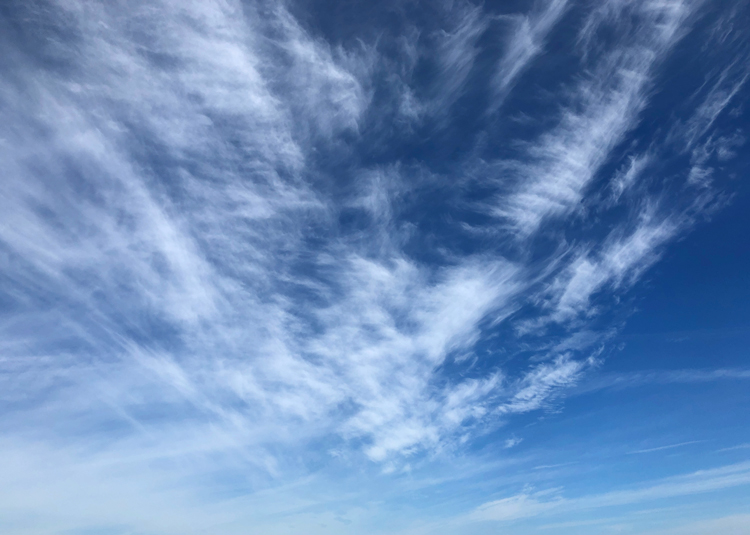
Early Morning Blue Sky
Awoke to better weather with no fog and an blue sky overlaid with some wispy clouds.
Several times last year, we had issues with our GPS (Global Positioning System) receiver sometimes failing to give us our position - a very important item for navigation. We had a backup GPS to use but encountered the same issue on and off so far this year. With spare time today and, after thinking about the issue, I thought the addition of our solar panels may have been shielding the GPS receiver enough to cause intermittent problems. It was simple enough job to move the receiver to the top of the pilot house from inside and, after a couple of hours, it was complete with good readings from the GPS. The real test will be the next few weeks.

GPS Receiver in New Position
Wednesday, June 26

Happy Birthday Judith!!!
It's Judy's birthday today everyone. Thanks to all for the birthday wishes.
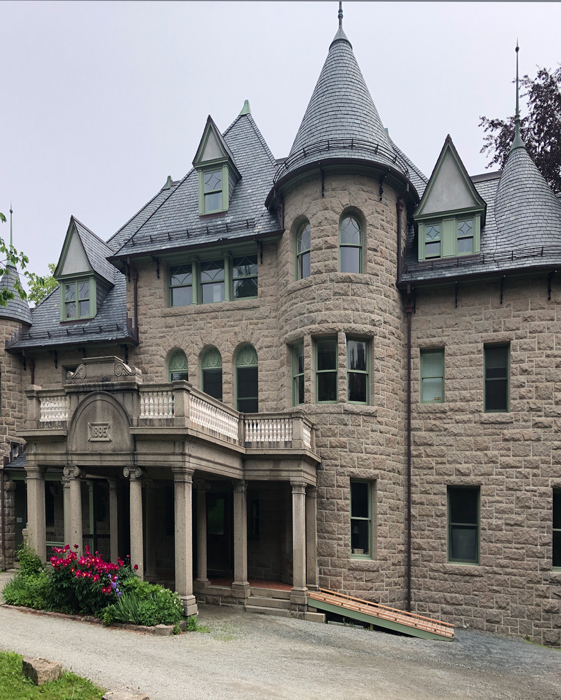
Turrets - One of the COA Buildings From 1885
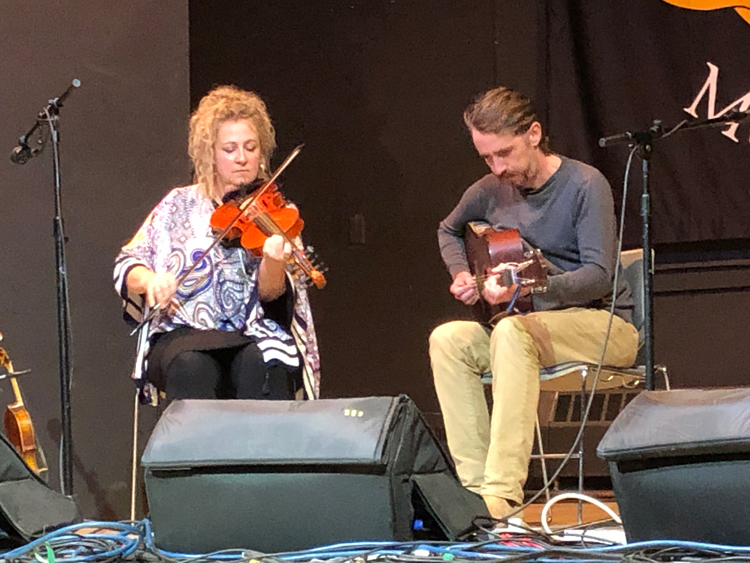
Eamon O'Leary and Liz Carroll
Thursday, June 27

Invictus
This morning we woke to a slightly foggy morning and a new neighbor anchoring a short distance away. "Invictus," a 200 foot superyacht had snuck in when we were asleep. Last year, the yacht had arrived in Camden while we were there and took up the whole Lyman-Morse dock. You can charter this vessel with crew, fuel, and food for $500,000 a week for 20 guests.
Judy was off to the Bar Harbor Y to swim for an hour while I did some work to install a small chart plotter in the dinghy. After getting the wiring in place, I spent some time in the COA Library that has good internet while waiting for Judy to get back.

COA Shoreline
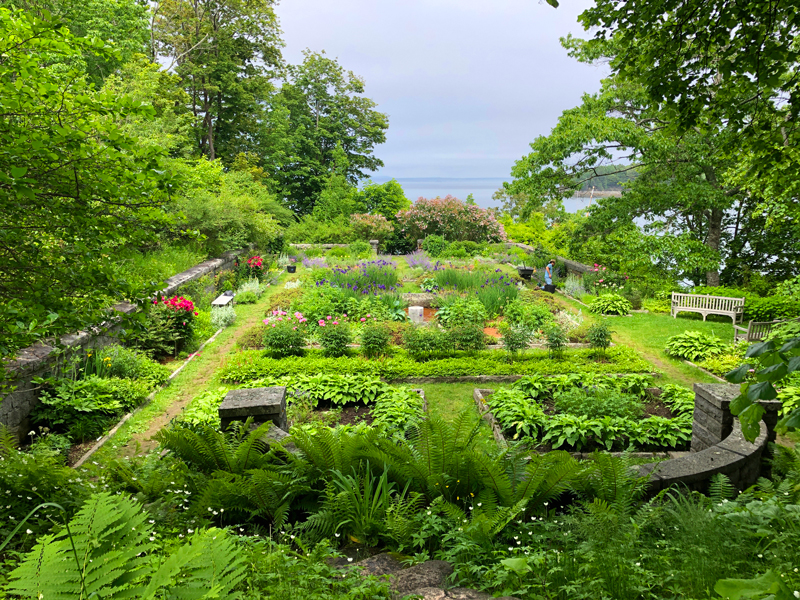
COA Gardens
Friday, June 28
Judy went off swimming again while I finished up the chart plotter. It should be useful to find our way around as we often go some distance in the dinghy; the depth sounder will also be a good tool to explore anchorages where the charts are a little vague as to depths.

New Garmin Chart plotter
Dean and Charlotte arrived from Brooklin after a successful launch and got a mooring nearby so we had a group of 4 for the last concert in the series. Tonight was the student concert that showcased the progress students had made in the week with the support of the faculty. The students were no slouches with a number attending for multiple years.


Saturday, June 29
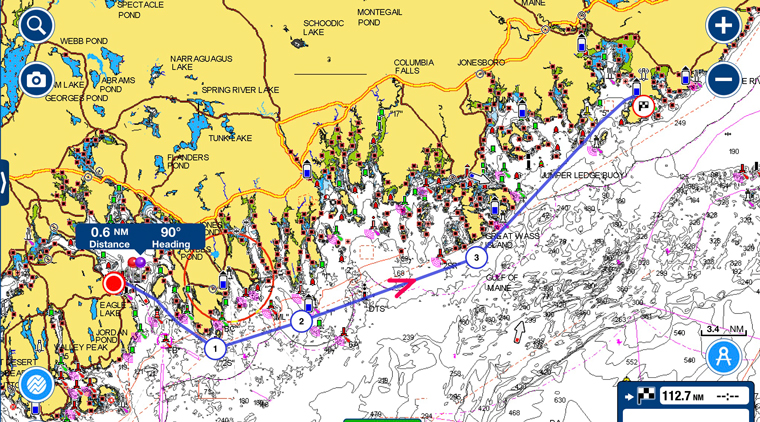
Bar Harbor to Cross Island - 48 nm
Up early today to get away on our trip north. Weather was fairly good with a light breeze, slightly overcast sky and small waves. We made our way out of Frenchman's Bay and were soon passing Schoodic Point on our port side.
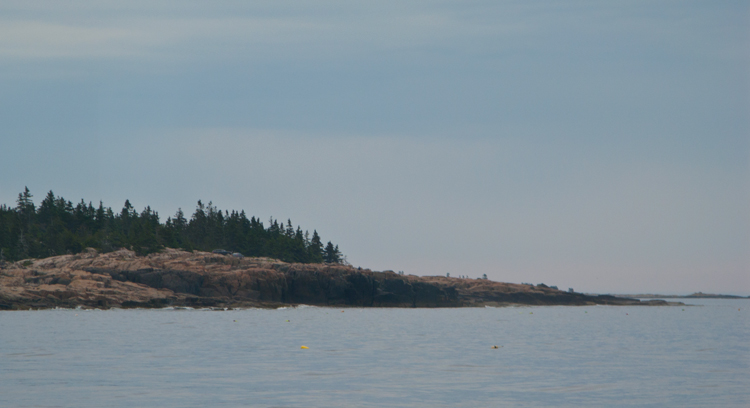
Schoodic Point
The Point is where Down East Maine begins. Civilization falls away after here and we enter a place where lobstering and fishing dominate. Most of the small coves are working harbors with fleets of lobster boats and trawlers and docks, often primitive, are piled high with traps and bait barrels. The needs of recreational boats are secondary here and the sailor needs to be largely self-supporting; no marinas, shore power, or showers here. The best place to tie at shore may be alongside a lobster boat!
This is also the start of dense fog, strong currents and higher tides as we progress up the funnel-shaped Bay of Fundy. While more primitive, Down East has some of the most spectacular scenery in Maine and its wildness results in many anchorages where you will be the only vessel.
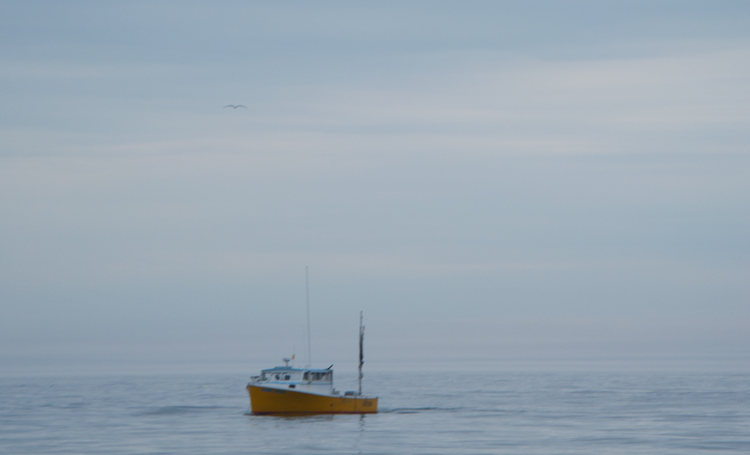
One of Two Boats Seen Today
The ride was kind of boring with a dull sky, smooth water, no boats and just a low landscape. The only thing of interest was trying figure out why some of the features on the chart were given their names. Some were obvious such as Bald Rock, just a rounded rock with no trees, or Sally, probably named after someone's wife or daughter. Bonney Chess Ledge was a bit more challenging; did manage to find a reference about a sailing vessel named Bonney Chase so she may well have found the ledge back in the day. Mistake Island wasn't really a mistake but a corruption of an Indian name "Moosebec" for the area. Drowned Boys Ledge definitely sounds ominous.
After an eventless seven hours, we made the final turn around Libby Island to see the fish farms on Cross Island and the Cutler Naval Station antennae farm. VLF Transmitter Cutler is the United States Navy's very low frequency (VLF) shore radio station. The station provides one-way communication to submarines in the Navy's Atlantic Fleet, both on the surface and submerged. The current Cutler Naval Station was built in 1960 and became operational on January 4, 1961. It has a transmission power of 2 megawatts. As with all VLF stations, the transmitter has a very small bandwidth, and so cannot transmit audio (speech) but only coded text messages, at a relatively low data rate. The antenna system consists of 26 towers that are about 900 feet high linked by cables to form two arrays covering over 2.5 miles by 1.25 miles.

Part of the Antenna Array at Cutler Naval Station
June 9 - 15 |
June 16 - 22 |
June 23 - 29 |
June 30 - July 6 |
July 7 - 13 |
July 14 - 20 |
July 21 - 27 |
Jul 28 - Aug 3 |
Aug 4 - 10 |
Aug 11 - 17 |
Aug 18 - 24 |
Aug 25 - 31 |
Sep 1 - 7 |
Sep 8 - 14 |
Sep 15 - 21 |
